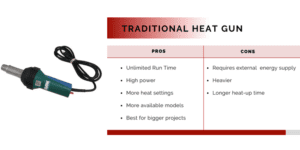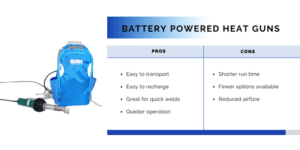With the appearance of portable heat guns on the market, we can wonder how they compare to previous models. Are they reliable? Will they provide the right amount of heat? Which ones are truly the best heat guns?
To help you decide which of the traditional plastic welder or the battery powered heat gun is best for you, Hapco Inc answers all these questions and more below.
Traditional Heat Guns
Traditional heat guns, or plastic welders, are a tried and true tool in industrial manufacturing and commercial roofing. Want to know the pros and cons of this model? Take a look below.
Pros
-
Unlimited Run Time
Since traditional heat guns are not self-powered, they must draw their power from an external energy supply. As long as the heat gun’s cord is connected to that energy supply, it will continue to provide power for your welding job. You never have to worry about the heat gun giving out mid-weld.
-
High Power
Power provided by an external energy supply is stronger and often more reliable than power provided by a rechargeable battery.
-
More Heat Settings and Available Models
Traditional heat guns have been used in the commercial roofing industry for much longer than battery-powered heat guns. As a result, significantly more product research and development has been performed for this model.
-
Best for Longer and Larger Projects
Traditional plastic welders have a longer run time than battery-powered models, which allows them to reach a higher welding temperature. Heat guns with a higher welding temperature are ideal for longer and larger welding jobs.
Cons
-
Requires an External Energy Supply
While battery-powered heat guns are powered by a rechargeable battery, traditional heat guns draw power from an external energy supply—like a generator.
-
Heavier
Traditional heat guns contain more parts than battery-powered heat guns, which makes them larger and bulkier.
-
Longer Heat-Up Time
While battery-powered heat guns take a mere 30 to 35 seconds to reach maximum welding temperature, traditional heat guns take longer to heat up. This results in more lost time at the start of a welding job.
Battery-Powered Heat Gun
The BAK LiiOn is the first portable, battery-powered heat gun in the entire industry to be successful. This heating tool can weld various thermoplastic materials—including TPO and PVC for roofing, flooring, tarps, plastic fabricating, and much more. Check out the top pros and cons of this model.
Pros
-
Easy to Transport
Our new battery-powered heat gun is handheld and extremely portable, featuring convenient backpack storage for the battery pack.
-
Simple Battery Recharging Feature
The BAK LiiOn is the industry’s first battery-powered heat gun designed for plastic welding jobs. The heat gun signals when the battery is empty and needs to be recharged.
-
Provides Adequate Power for Quick Welds
Wondering how long it takes a portable, battery-powered heat gun to heat up? In most cases, battery-powered heat guns only take between 30 and 35 seconds to reach the ideal temperature for PVC and TPO welding. This makes them perfect for smaller welding jobs. The average run time for a battery-powered heat gun is 45 minutes.
-
Quieter Operation
While the BAK RiOn—a traditional heat gun model—reaches 64 decibels during operation, its battery-powered counterpart only reaches 55 decibels.
Cons
-
Comparably Shorter Run Time
The main drawback to a battery powered heat gun is that they have a limited run time. Although convenient, the rechargeable battery doesn’t last as long as a continuous, external power supply.
-
Fewer Options Available
Since the BAK LiiOn is the first successful battery powered heat gun model, options are more limited. Minimal product research and development has been performed compared to its competitors which have a wider range of fully portable heat guns.
-
Produces Less Airflow
Compared to the BAK RiOn and other traditional heat gun models, the portable, battery-powered heat gun produces less airflow.
Conclusion
While not providing the high power level of traditional heat guns, battery-powered heat guns such as the BAK LiiOn offer more flexibility thanks to their portability and are great for quick welds.
Even when compared to other portable heat guns, this new model is providing many useful features and a more robust build for commercial roofing and plastic welding in general.
The World’s Largest BAK Distributor
Are you looking for the right TPO or PVC welding gun for your commercial roofing, industrial fabrication or geotextiles business? Hapco, Inc. has you covered with the industry’s most reliable heating tools, including convenient battery-powered models. Backed by 30 years of experience and factory-trained personnel, we have the right heat gun for every job.
As the preferred heat tools supplier for all your industrial manufacturing and construction needs, Hapco has the right heat gun for every welding job. Our portable, battery-powered heat gun—the BAK LiiOn—comes with a backpack for convenient storage of the heat gun, the battery, and the charger. Shop the BAK LiiOn today for reliable welding power.
Comments are closed.






Recent Comments